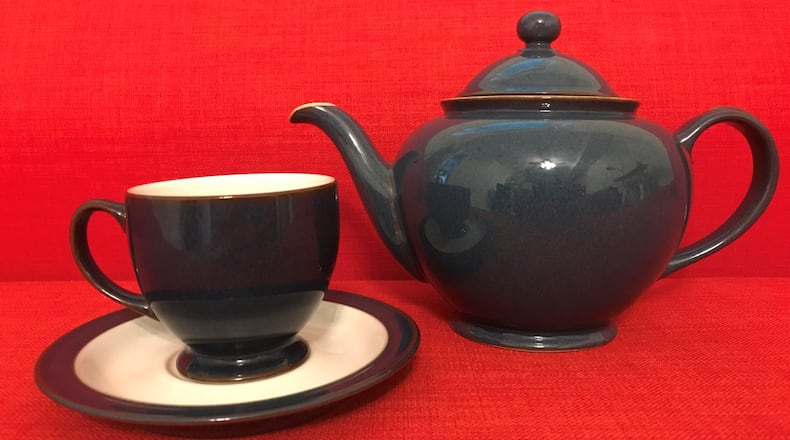This Atlanta weather of late is insufferable. The endless rain makes me foul-tempered and ill-mannered.
“You have to make your own sunshine,” my mom used to say when the weather was lousy. I usually met that with an eye roll.
There is one thing that cheers me up on dreary days, though: tea.
Just the other day, while sheets of rain fell for hours, my husband was forced to listen to his ornery wife air a litany of weather-induced grievances. He left the room and returned five minutes later with a couple of overpriced Girl Scout shortbread cookies and a cup of tea served in the Denby. The Denby! Suddenly, the day didn’t seem so bleak.
Denby is a fancy brand of British stoneware. A Denby teapot, cups and saucers were my mom’s wedding gift to me, and that pottery has given me plenty of sunshine. We’ve packed and unpacked that set through many a move. My husband doesn’t give a whiff for any of it, but he knows I adore it. The Denby makes me feel slightly classy, even when I look frumpy, which is pretty much all the time. Living among a man clan, the Denby is one of my few feminine collection items.
I became enamored with tea in seventh grade, when a British family with four kids moved into the neighborhood, because the father had taken a yearlong teaching position. From the Brockingtons, I learned words like "Twinings." I discovered there was more to tea than bags of Lipton, that a world of loose tea existed, and that each blend had a distinctive aroma and taste. When they returned to their home in Manchester, their daughter Alice gifted me all the colorful metal Twinings canisters they'd accumulated during their time in the States. There had to have been at least 40 tins, all empty. I suppose the Brockingtons needed their daily sip of home.
Because our families got along so swimmingly, we vacationed the next summer on their soil. It was three weeks filled with U.K. tea rituals. Mornings: tea with breakfast. Afternoons: far better, because tea involved sweet stuff, biscuits, which my siblings and I repeatedly referred to as cookies, because it incited such a reaction from those British kids. Same thing with the term “dish towel.” Alice would get so exasperated. “That is not a dish towel. It is a tea towel,” she’d say in her British accent, enunciating every consonant and never using contractions.
I thought about Alice and her proper ways with tea when I cracked open "Jane Eyre" for the first time in high school. When 10-year-old, maltreated Jane is sent to Lowood, a charity school for orphaned girls, the benevolent superintendent, Miss Temple, takes pity on her and the sick Helen Burns by inviting the deprived girls to her room for tea. Jane recalls: "How pretty, to my eyes, did the china cups and bright teapot look, placed on the little round table near the fire! How fragrant was the steam of the beverage, and the scent of the toast!"
Bah. The trio had to split one measly slice of toast. And, a few pages later, Helen Burns dies.
Oh, but all British tea moments aren’t so pathetically sad. Don’t you love that scene in “Mary Poppins”? It’s the one where she and the Banks children and a cast of curious characters have a magical tea party in midair that leaves them laughing silly and breaking into song. “It’s supercalifragilisticexpialidocious….”
“A tea party on the ceiling? Outrageous!” cries their strict father, when he learns of the impermissible outing.
Melinda Ennis-Roughton, the wife of retired Atlanta Journal-Constitution Senior Managing Editor Bert Roughton, caused more than one laughable British outrage due to tea when Bert was stationed at an AJC bureau in England in the late 1990s. She was unaware of certain tea customs, like when the friend of their 4-year-old son Christian came over for a play date after school and the friend’s mother asked, “Will you be giving the boys tea?”
Melinda’s spoken reply: “Yes.” Her unspoken thoughts: “I don’t think Christian will drink tea, but if Harvey wants tea …”
Out came the tea and biscuits. Harvey was aghast. He’d expected fish fingers, aka fish sticks, the choice of all normal English children for their casual, early evening meal at home, known as “tea.”
Oops.
Melinda even managed to botch the tea she brewed for a moving company crew. The workers requested hot tea. She obliged. They drank it. But when the movers returned to the house the next day to finish the job, they all brought their own tea bags.
“They are very picky about it,” Melinda said of the British and their ways with tea.
Quite so.
My younger son is dating a girl whose father, Guy Rawlins, is British. Although he’s lived in the States since 1995, Guy is still quite particular about his tea.
"Tea has been present in my life as early as I can remember," said Guy, who grew up in Newcastle-under-Lyme — not far from The Potteries, famed for its china and earthenware. "I have a mug of tea pretty much every morning, followed swiftly by a cup of coffee. But I start with tea."
He grew up on PG Tips, which he dubs “the Nestle brand of tea,” and he’s been loyal to that label ever since. As for the ritual: “The steeping is quick on this Indian tea — 20 seconds — because it is bitter. Then, I add a splash of milk. I feel like I’m at home when I’m having a mug of hot tea.”
Mug, mind you. Not tea cup. “Tea cup and saucer is fancy,” Guy said. “To me, the mug makes it more down to earth.”
Most of his mugs hail from Staffordshire, and some of his favorites are made by British ceramics manufacturer Emma Bridgewater, which are sold in Atlanta at Star Provisions, he noted. "Lovely designs: birds, mountains …"
If this insufferable weather continues, Guy and I need to have a tea party. I’ll bring my Denby pot, and a cup and saucer. He can bring his down-to-earth Emma Bridgewater. I’ll steep my loose tea. He can have his 20-second brewed bag of PG Tips. It’ll be supercalifragilisticexpialidocious, for sure.
RELATED:
Read more stories like this by liking Atlanta Restaurant Scene on Facebook, following @ATLDiningNews on Twitter and @ajcdining on Instagram.
About the Author






